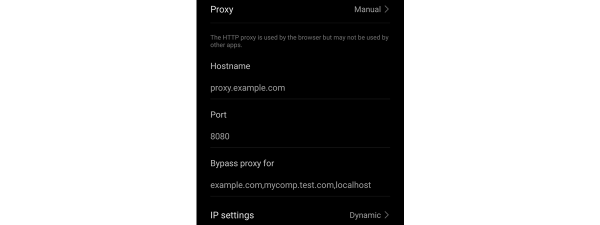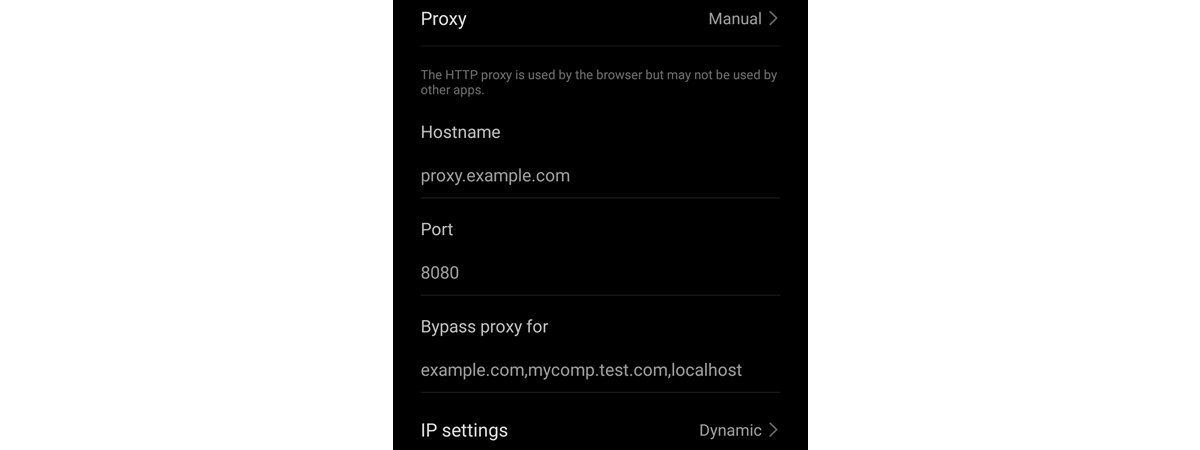
Do you have to use a Wi-Fi proxy server for Android to access the internet at school or work? Or maybe you decided to configure an Android proxy server to protect your online privacy? Proxy servers are practical tools that act as intermediaries between you and the rest of the internet, and configuring one is easy. This tutorial shows you how to set a Wi-Fi proxy server for Android smartphones and tablets. We included Android 12 and Samsung smartphones, so read on to find out more:
NOTE: This guide was created using a Google Pixel 4a using Android 12 and a Samsung Galaxy A51 using Android 11. If you do not know your Android version, read this article on how to check the Android version on your smartphone or tablet. The procedures are similar on most Android-powered devices, although you might come across some small differences, depending on your device’s manufacturer.
First things first: About Android proxy settings for Wi-Fi networks
You can use a Wi-Fi proxy server to protect your identity online or access the internet when you are in a business network. While using the Android proxy, websites don’t identify your specific device, but rather the proxy server you have set for the Wi-Fi connection. If you want to learn more, we explained in great detail what a proxy server is in the following article: What is a proxy server and what does it mean?.
Even if you need to use the same Android proxy settings for different Wi-Fi networks, you must set them up one by one. To configure the Wi-Fi proxy settings, Android requires slightly different steps, depending on whether you’re setting the proxy server for an existing connection or a new one. Don’t worry, though; your Android smartphone or tablet remembers the proxy server associated with every Wi-Fi connection, so you only have to do this once. Your network administrator or proxy provider should give you the necessary details to connect.
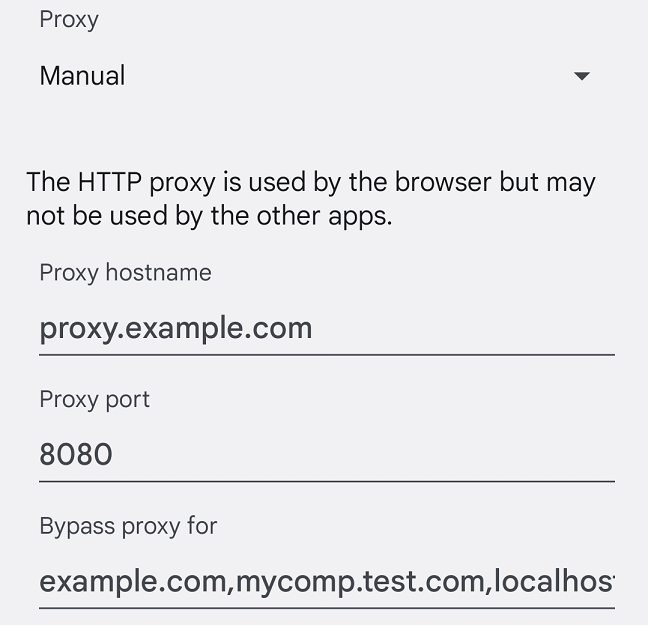
Proxy settings on Android devices
If you’re wondering how to run Android apps on proxy Wi-Fi, the answer is a bit more complicated, and it all comes down to how each app was designed. Some apps are programmed to use the Android proxy settings, some, like browsers, can have their individual proxy settings, while others ignore Wi-Fi proxy settings altogether. That is why you could encounter certain apps that don’t work with your proxies. Unfortunately, if an app is not designed to use the Android proxy settings, there is no way to force it.
TIP: If you’re concerned about online privacy and security, you might also be interested to know when to use a proxy and when to use a VPN.
How to set an Android proxy server for your Wi-Fi network on Android 12
You can change the Wi-Fi proxy settings on Android to use a specific proxy server each time you connect to a network. As you’re about to see, the steps are similar, regardless of whether you’re setting up the proxy for the current network or configuring a new connection. To begin, open the Settings app and tap on Network & internet. Next, access Internet to see available network connections.
NOTE: From this point on, Wi-Fi must be active on your Android device.
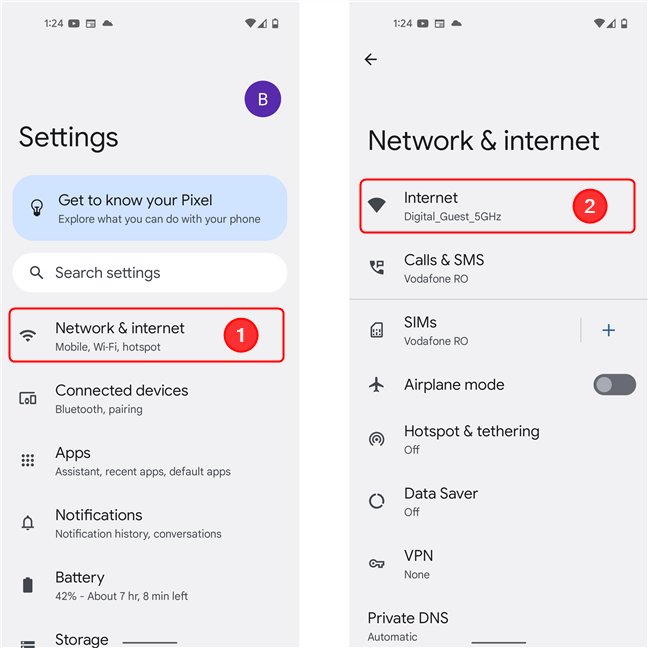
Go to Network & internet, then tap on Internet to see the available networks
You are shown a list of the Wi-Fi networks available in your area. Depending on whether you’re setting the proxy server for an existing connection or a new one, accessing a network’s Advanced options is slightly different.
Set an Android proxy for existing or saved connections
The first steps can slightly differ depending on the status of the network:
- If you’re already connected to the network you wish to add a proxy server to, tap on the network on the Internet page of the Settings app
- If you want to add a proxy to a saved network that’s in range, but you’re not connected to (it’s present in the Available networks list as Saved), tap and hold the name of the network, then select Modify.
The next screen shows your Wi-Fi connection’s Network details. Tap on the Edit button in the top-right corner. Its icon looks like a pencil.
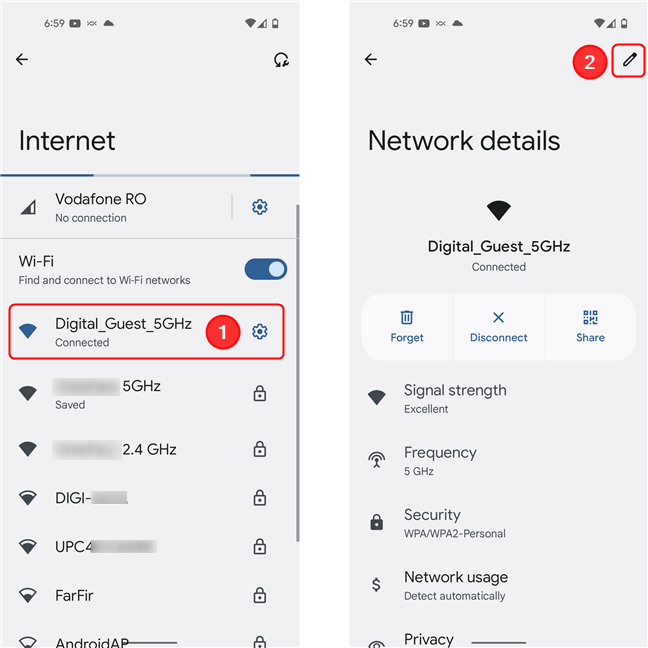
Select the network you want to modify, then tap on the button in the upper right of the screen
This opens a pop-up window showing your network’s name on top and requesting a password. Here, tap on Advanced options to extend the menu. Next, locate the Proxy section and tap on its default value, None. The drop-down menu that appears has three options: None, Manual, and Proxy Auto-Config. Choose whether you want to manually enter the Wi-Fi proxy server or use a proxy auto-configuration address.
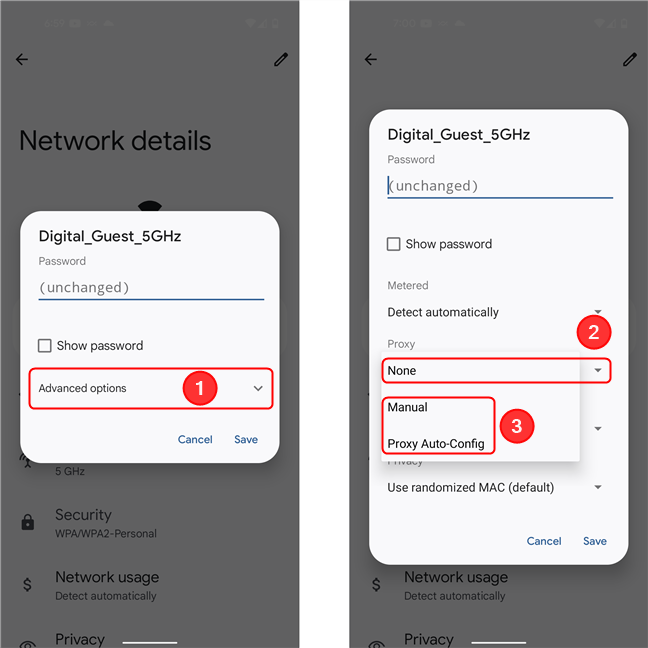
The proxy settings are in the Advanced options section
If you choose Manual, the pop-up window reveals three additional fields. Under Proxy hostname, enter either the hostname of the proxy server that you want to use (in the suggested format: proxy.example.com) or its IP address. Then, you need to enter the port (the default used by most HTTP proxy servers is 8080). You can also Bypass proxy for certain websites if you insert their addresses. If you choose Proxy Auto-Config, you get access to the PAC URL field. The value that you enter should follow the format: https://www.example.com/proxy.pac.
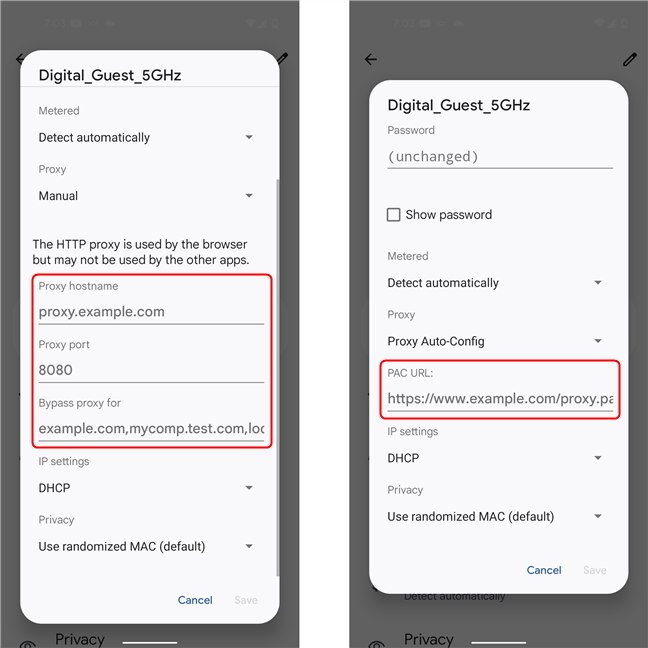
Insert the proxy information, then tap Save
When you’re done setting everything up, tap the option in the bottom-right corner of the pop-up to apply your changes. For existing networks, the button is named Save, as seen above.
Set an Android proxy for new connections
Just like in the previous method, start by tapping on the network name on the Internet page of the Settings app. If it’s a new (or unsaved) network, you can now see the Advanced options section in the pop-up window requesting a password. Tap on Advanced options to expand it. This reveals the Proxy setting, which displays its default, None, and a down arrow. Tap on the arrow to open the options for configuring the Android proxy server.
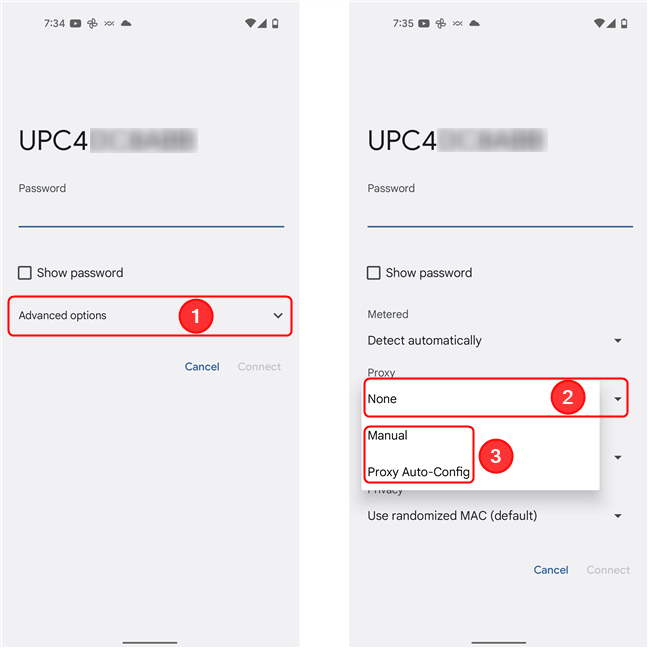
Tap on Advanced options, then on the default value below Proxy
The resulting menu has three options: None, Manual, and Proxy Auto-Config. If you choose Manual, you need to enter the Proxy hostname, in the suggested format: proxy.example.com or its IP address. Then, you need to enter the port. You can also Bypass proxy for certain websites if you insert their addresses. If you choose Proxy Auto-Config, you only need to insert the auto-config URL.
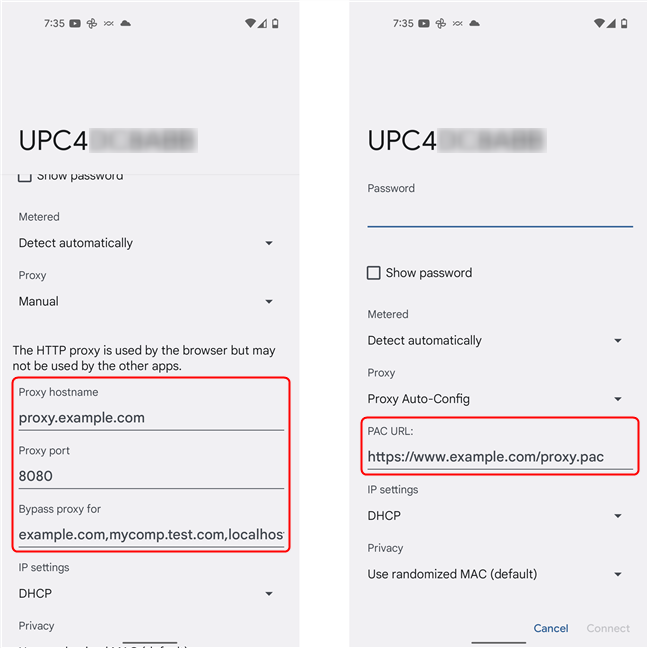
Insert the proxy info
Now, that you entered all the details for the proxy server, continue the normal authentication process. When you’re done setting everything up, tap the option in the bottom-right corner of the pop-up to apply your changes. For new networks, the button is named Connect. From now on, each time it’s connected to the selected Wi-Fi network, your Android smartphone or tablet uses the proxy server you configured.
How to set a Wi-Fi proxy server for Android on Samsung Galaxy devices
Samsung has slightly different Wi-Fi proxy settings on their Android devices. Open Settings and tap on Connections. Then, tap the first option on the screen, Wi-Fi.
NOTE: The Wi-Fi option has to be enabled on your Samsung Android device if you want to continue.
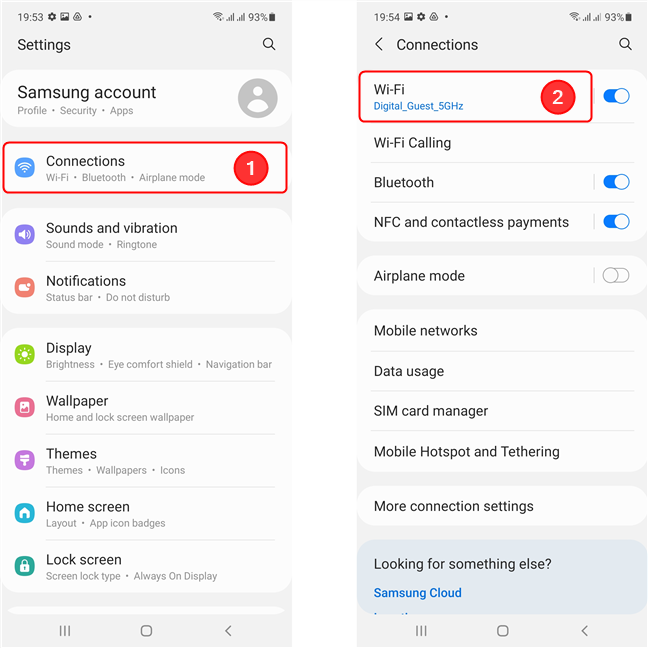
Access Wi-Fi to see available networks
You are shown a list of all the available Wi-Fi networks. The network you’re currently connected to is displayed on top. Next, you have three options, depending on the network you want to modify:
- If you’re already connected to the network you wish to add a proxy server to, press on the gear icon next to your Current network
- If you want to add a proxy server to an available network you’ve never connected to before, tap on its name.
- If you have a network that you previously connected to in the Available networks, tapping on its name automatically connects the smartphone to it. If you want to only change the proxy settings without actually connecting to it, tap and hold the name of that network, then select Manage network settings.
Whichever of the three options you go with, the next step is identical: tap on Advanced.
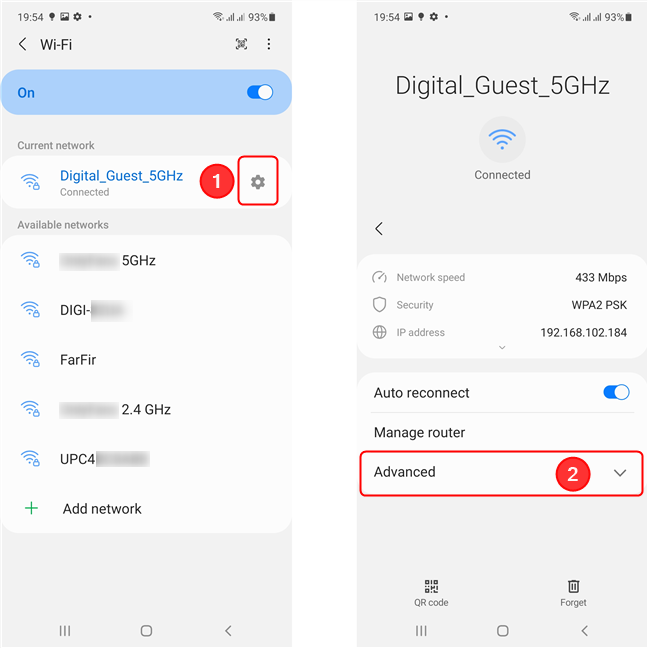
Select the network, then tap on Advanced
This reveals several options, including the Proxy setting for the selected network. Tap on its default value, None, to reveal other options for configuring the Android proxy server. Next, choose whether you want to manually enter the Wi-Fi proxy server or use a proxy auto-configuration address.
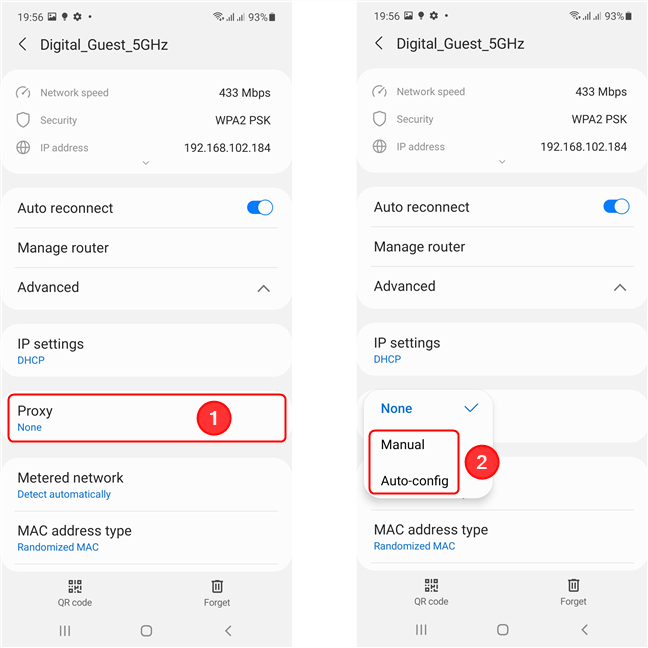
Tap on the Proxy section, then select the type of proxy configuration
The Manual option reveals three additional fields, but only the first two are required to set up the Android proxy server: under “Proxy host name,” enter either the hostname of the server you want to use (in the suggested format: proxy.example.com) or its IP address; enter a port under Proxy port - the default used by most proxy servers is 8080. Optionally, you can specify for which web pages your device should bypass the proxy and establish a direct connection. If you choose the Auto-Config setting for your proxy server, you are required to insert the “PAC web address.” Enter the URL for that proxy or its configuration script.
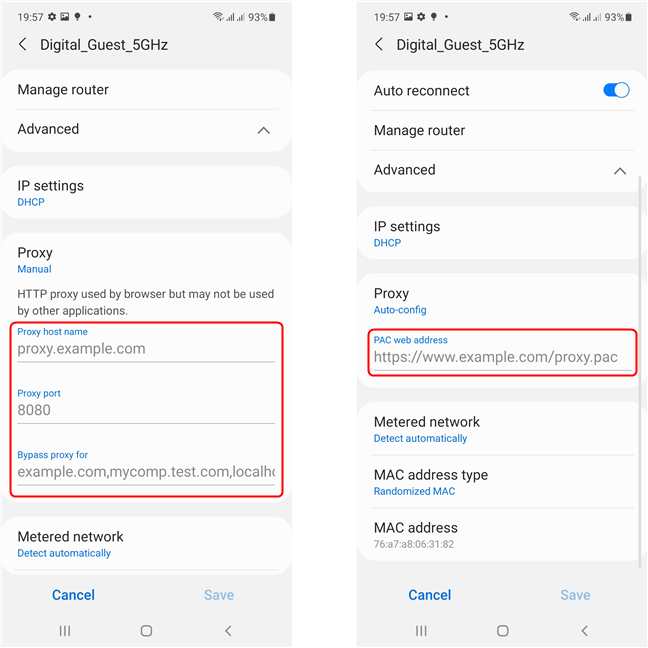
Enter the info for the proxy server
You can now tap on Save (for known networks) or continue the authentication process (for new networks) and then click Connect. The next time you connect to the internet using that connection, you will use the proxy server.
Why do you use a Wi-Fi proxy server on your Android smartphone or tablet?
Most Android owners only use a Wi-Fi proxy server on their devices if it’s required to access the internet on a business or school network. However, there are users who think of it as a good way to protect their online identity and avoid giving away their location. What about you? Why did you decide to use a Wi-Fi proxy server? Let us know in the comments.







